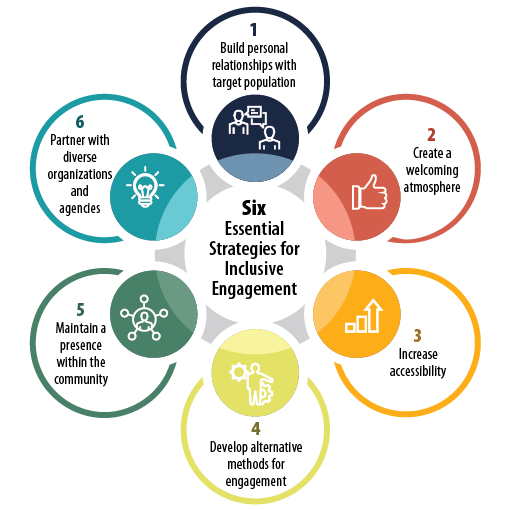Effective community engagement and outreach takes careful planning and acknowledgement that each population that we work with is unique and offers us opportunities to broaden our understanding of what makes a community.
Here are some strategies to consider when building your outreach and engagement approaches:

Six Essential Strategies for Inclusive Engagement
- Build personal relationships with target population
- Create a welcoming atmosphere
- Increase accessibility
- Develop alternative methods for engagement
- Maintain a presence within the community
- Partner with diverse organizations and agencies
Source: McGinn, Mayor Mike. “Inclusive Outreach and Public Engagement Guide.” (pdf)
Below are some ways to apply these strategies when considering culturally competent outreach:
- Understand and recognize the differences and disparities that make some cultural, ethnic, or racial groups more likely to respond to one kind of outreach than another. Consider transportation, childcare, literacy, and other challenges to meeting times and locations. Try to meet people where they are at rather than where you expect them to be.
- Before scheduling events, check that they do not conflict with religious/cultural holidays.
- Make sure to understand that “this is the way we’ve always done it” might not work for other cultural groups. For example, try switching the time of your event to accommodate a range of schedules.
“Cultural competence is the ability of individuals and systems to respond respectfully and effectively to people of all cultures, classes, races, ethnic backgrounds, sexual orientations, and faiths or religions in a manner that recognizes, affirms, and values the worth of individuals, families, tribes, and communities, and protects and preserves the dignity of each.” From the U.S. Department of Health & Human Services.
More Outreach Resources
Use these resources to learn more about best practices for outreach:
- Community Outreach Toolkit – United States Census Bureau (pdf)
A practical guide and resource for inclusive public engagement. - Inclusive Outreach and Public Engagement Guide – Seattle Office of Civil Rights (pdf)
Best practices and research-backed recommendations to reach and engage audiences around the country used by the United States Census Bureau - Partnering with Hard-to-Connect Families - TACQE
A carefully considered list of links to websites and documents that can give professionals an advantage when partnering with parents

